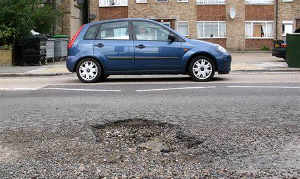How does climate change affect flooding?

Authored by FloodFlash
Last month, we introduced what climate change is, how it differs to global warming, and had a look at why man-made climate change is relevant to insurance. The relationship between climate and flooding is complex. This can make it difficult to accurately model flood risk. We asked FloodFlash risk modeller Dr Mano Muthusamy about this relationship and how FloodFlash incorporate the complexities and uncertainties into our models.
What are the impacts of man-made climate change?
Man-made, or anthropogenic, climate change will have many impacts which will vary across the world. According to the IPCC, it is likely that global temperatures will continue to rise over the coming decades. More extreme weather will also become increasingly common. The exact outcome of our impact on the climate depends on many factors, with existing weather patterns and conditions playing a key role. However, it is certain that man-made climate change will have many implications for our way of life, affecting almost everything, from food security to infrastructure, biodiversity to migration.
The Met Office project that the UK will experience warmer and wetter winters, hotter and drier summers, and more frequent and intense weather extremes due to man-made climate change. The 40ºC highs from last summer are likely to become more frequent, along with more regular and intense storms.
In the US, NASA expect longer wildfire seasons, more droughts and heatwaves, and more intense hurricanes. Many in the US are already experiencing these changes. In September 2022, Hurricane Ian hit the US. It was one of the strongest and costliest hurricanes in the US to date, with losses estimated as high as $100bn.
It is likely that events like wildfires, droughts, and floods will become more frequent and more intense due to man-made climate change.
The ‘Global Warming – Flooding’ paradox
Last month, we described climate change as ‘long-term shifts in temperatures and weather patterns’. This includes changes to the frequency and intensity of rainfall, and therefore flooding. The impact of climate change on flooding is twofold:
There is enough evidence to show that man-made climate change has resulted in rising temperatures. A higher atmospheric temperature results in a higher saturation vapour pressure in the atmosphere. Put simply, a warmer atmosphere can hold more water. This causes more rainfall during an extreme event.A warmer climate also results in a warmer soil surface. This reduces soil moisture content, which means the soil surface can now hold more water during a rainfall event. This reduces the amount of overflow water, limiting flooding.
A warming climate results in more rainfall, but also increases the soil’s capacity to hold more water. So, the picture is a little more complicated than simply ‘climate change causes flooding to be more extreme’. The flood pattern in a particular area will change depending on which one of these has a higher impact in that specific area.
What else affects flood risk?
It is also important to consider the other factors that affect the flooding patterns in an area – besides rainfall. The catchment size and catchment type play a key role, along with the existing conditions in the area. Catchment type refers to whether the area is more urban or rural. This is critical when it comes to flooding. In urban areas, the percentage of ground that is impervious (doesn’t allow water to flow through) is high, with widespread concrete. In such locations, the increased capacity of the soil to hold moisture will have little impact. This means increased rainfall will likely cause more frequent and catastrophic floods.
How has climate change affected English flood trends?
It is clear that there remains uncertainty around the impacts climate change has on flooding. We analysed the river flow records for England over the past 50 years to see if there were any obvious changes in flood trends. We looked at the top three river flow records for each river gauge station in England and plotted when they occurred between 1972 and 2020.
The number of top three river flow occurrences each year between 1972 and 2022. There is a clear increase – suggesting that there is an increasing flood trend in England.
Between 1972 and 2020, the number of top-three river flows per year increased. The total number of top-three occurrences between 2000 and 2020 is 718, significantly higher than the 402 occurrences pre-2000. This indicates a generally increasing trend in flooding in England. However, it is important to note that other drivers may have contributed to this trend alongside increased rainfall due to climate change. For example, land use changes, such as increased urbanisation, has a big impact. Further, the Western Europe flood in Autumn of 2000 distorts the number of occurrences significantly.
How does FloodFlash incorporate climate change into our pricing?
It is clear that man-made climate change and the impact it has on flooding is complex. This complexity affects insurers model flood risk, which has consequences for pricing flood insurance. One of the reasons flood insurance premiums are increasing is to account for this uncertainty.
At FloodFlash, we incorporate the impact of climate change into our pricing models in two ways and at two stages. We use climate models and global circulation models (GCMs) to derive the inputs we need for our catastrophe models, such as rainfall. Both of these models are based on well-documented physical processes to simulate the transfer of energy and materials through the climate system. They are widely used for weather forecasting and for projecting climate change scenarios. While these models are good at global and regional scale climate statistics, they may not provide a representative description of the local climate that we need. If we used these models without adjusting for local climate, the price would not fairly represent a property’s flood risk.
While climate models help us to understand how rainfall is changing, they are too large-scale to provide an accurate indication of a property’s flood risk.
To account for the local climate, we use a second method. This involves adjusting the price by using the property’s flood history in recent years. A property’s flood history is the best proxy for the impact of climate change on flooding at the property level. It is also a more transparent approach than complex climate models. This makes it far easier to explain to FloodFlash brokers and clients. We want our brokers and clients to understand how we view their flood risk as much as possible.
To speak to someone at FloodFlash about this article, CLICK HERE, leave a message and youTalk-insurance will pass your enquiry on.





